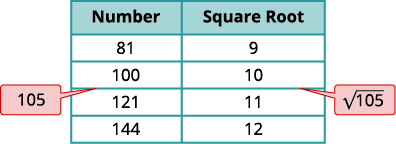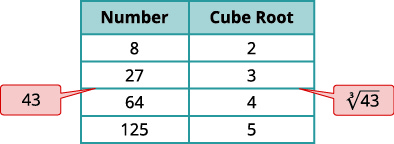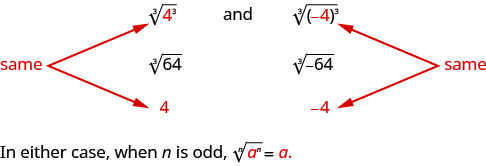17.2: Simplify Expressions with Roots
- Last updated
- Aug 13, 2020
- Save as PDF
- Page ID
- 46423
( \newcommand{\kernel}{\mathrm{null}\,}\)
Learning Objectives
By the end of this section, you will be able to:
- Simplify expressions with roots
- Estimate and approximate roots
- Simplify variable expressions with roots
Before you get started, take this readiness quiz.
- Simplify: a. (−9)2 b. −92 c. (−9)3
If you missed this problem, review Example 2.21. - Round 3.846 to the nearest hundredth.
If you missed this problem, review Example 1.34. - Simplify: a. x3⋅x3 b. y2⋅y2⋅y2 c. z3⋅z3⋅z3⋅z3
If you missed this problem, review Example 5.12.
Simplify Expressions with Roots
In Foundations, we briefly looked at square roots. Remember that when a real number n is multiplied by itself, we write n2 and read it 'n2 squared’. This number is called the square of n, and n is called the square root. For example,
132 is read "13 squared"
169 is called the square of 13, since 132=169
13 is a square root of 169
Definition 17.2.1: Square and Square Root of a Number
Square
If n2=m, then m is the square of n.
Square Root
If n2=m, then n is a square root of m.
Notice (−13)2=169 also, so −13 is also a square root of 169. Therefore, both 13 and −13 are square roots of 169.
So, every positive number has two square roots—one positive and one negative. What if we only wanted the positive square root of a positive number? We use a radical sign, and write, √m, which denotes the positive square root of m. The positive square root is also called the principal square root.
We also use the radical sign for the square root of zero. Because 02=0,√0=0. Notice that zero has only one square root.
Definition 17.2.2: Square Root Notation
√m is read "the square root of m."
If n2=m, then n=√m, for n≥0.
We know that every positive number has two square roots and the radical sign indicates the positive one. We write √169=13. If we want to find the negative square root of a number, we place a negative in front of the radical sign. For example, −√169=−13.
Example 17.2.1
Simplify:
- √144
- −√289
Solution:
a.
√144
Since 122=144.
12
b.
−√289
Since 172=289 and the negative is in front of the radical sign.
−17
Exercise 17.2.1
Simplify:
- −√64
- √225
- Answer
-
- −8
- 15
Exercise 17.2.2
Simplify:
- √100
- −√121
- Answer
-
- 10
- −11
Can we simplify −√49? Is there a number whose square is −49?
(___)2=−49
Any positive number squared is positive. Any negative number squared is positive. There is no real number equal to √−49. The square root of a negative number is not a real number.
Example 17.2.2
Simplify:
- √−196
- −√64
Solution:
a.
√−196
There is no real number whose square is −196.
√−196 is not a real number.
b.
−√64
The negative is in front of the radical.
−8
Exercise 17.2.3
Simplify:
- √−169
- −√81
- Answer
-
- not a real number
- −9
Exercise 17.2.4
Simplify:
- −√49
- √−121
- Answer
-
- −7
- not a real number
So far we have only talked about squares and square roots. Let’s now extend our work to include higher powers and higher roots.
Let’s review some vocabulary first.
We write: We say: n2n squared n3n cubed n4n to the fourth power n5n to the fifth power
The terms ‘squared’ and ‘cubed’ come from the formulas for area of a square and volume of a cube.
It will be helpful to have a table of the powers of the integers from −5 to 5. See Figure 8.1.2

Notice the signs in the table. All powers of positive numbers are positive, of course. But when we have a negative number, the even powers are positive and the odd powers are negative. We’ll copy the row with the powers of −2 to help you see this.

We will now extend the square root definition to higher roots.
Definition 17.2.3: Nth Root of a Number
If bn=a, then b is an nth root of a.
The principal nth root of a is written n√a.
The n is called the index of the radical.
Just like we use the word ‘cubed’ for b3, we use the term ‘cube root’ for 3√a.
We can refer to Figure 8.1.2 to help find higher roots.
43=643√64=434=814√81=3(−2)5=−325√−32=−2
Could we have an even root of a negative number? We know that the square root of a negative number is not a real number. The same is true for any even root. Even roots of negative numbers are not real numbers. Odd roots of negative numbers are real numbers.
Properties of n√a
When n is an even number and
- a≥0, then n√a is a real number.
- a<0, then n√a is not a real number.
When n is an odd number, n√a is a real number for all the values of a.
We will apply these properties in the next two examples.
Example 17.2.3
Simplify:
- 3√64
- 4√81
- 5√32
Solution:
a.
3√64
Since 43=64.
4
b.
4√81
Since (3)4=81.
3
c.
5√32
Since (2)5=32.
2
Exercise 17.2.5
Simplify:
- 3√27
- 4√256
- 5√243
- Answer
-
- 3
- 4
- 3
Exercise 17.2.6
Simplify:
- 3√1000
- 4√16
- 5√243
- Answer
-
- 10
- 2
- 3
In this example be alert for the negative signs as well as even and odd powers.
Example 17.2.4
Simplify:
- 3√−125
- 4√16
- 5√−243
Solution:
a.
3√−125
Since (−5)3=−125.
−5
b.
4√16
Think, (?)4=−16. No real number raised to the fourth power is negative.
Not a real number.
c.
5√−243
Since (−3)5=−243.
−3
Exercise 17.2.7
Simplify:
- 3√−27
- 4√−256
- 5√−32
- Answer
-
- −3
- not real
- −2
Exercise 17.2.8
Simplify:
- 3√−216
- 4√−81
- 5√−1024
- Answer
-
- −6
- not real
- −4
Estimate and Approximate Roots
When we see a number with a radical sign, we often don’t think about its numerical value. While we probably know that the √4=2, what is the value of √21 or 3√50? In some situations a quick estimate is meaningful and in others it is convenient to have a decimal approximation.
To get a numerical estimate of a square root, we look for perfect square numbers closest to the radicand. To find an estimate of √11, we see 11 is between perfect square numbers 9 and 16, closer to 9. Its square root then will be between 3 and 4, but closer to 3.

Similarly, to estimate 3√91, we see 91 is between perfect cube numbers 64 and 125. The cube root then will be between 4 and 5.
Example 17.2.5
Estimate each root between two consecutive whole numbers:
- √105
- 3√43
Solution:
a. Think of the perfect square numbers closest to 105. Make a small table of these perfect squares and their squares roots.
| √105 | |
 |
|
| Locate 105 between two consecutive perfect squares. | 100<105<121 |
| √105 is between their square roots. | 10<√105<11 |
b. Similarly we locate 43 between two perfect cube numbers.
| 3√43 | |
 |
|
| Locate 43 between two consecutive perfect cubes. |  |
| 3√43 is between their cube roots. |  |
Exercise 17.2.9
Estimate each root between two consecutive whole numbers:
- √38
- 3√93
- Answer
-
- 6<√38<7
- 4<3√93<5
Exercise 17.2.10
Estimate each root between two consecutive whole numbers:
- √84
- 3√152
- Answer
-
- 9<√84<10
- 5<3√152<6
There are mathematical methods to approximate square roots, but nowadays most people use a calculator to find square roots. To find a square root you will use the √x key on your calculator. To find a cube root, or any root with higher index, you will use the y√x key.
When you use these keys, you get an approximate value. It is an approximation, accurate to the number of digits shown on your calculator’s display. The symbol for an approximation is ≈ and it is read ‘approximately’.
Suppose your calculator has a 10 digit display. You would see that
√5≈2.236067978 rounded to two decimal places is √5≈2.24
4√93≈3.105422799 rounded to two decimal places is 4√93≈3.11
How do we know these values are approximations and not the exact values? Look at what happens when we square them:
(2.236067978)2=5.000000002(3.105422799)4=92.999999991(2.24)2=5.0176(3.11)4=93.54951841
Their squares are close to 5, but are not exactly equal to 5. The fourth powers are close to 93, but not equal to 93.
Example 17.2.6
Round to two decimal places:
- √17
- 3√49
- 4√51
Solution:
a.
√17
Use the calculator square root key.
4.123105626…
Round to two decimal places.
4.12
√17≈4.12
b.
3√49
Use the calculator y√x key.
3.659305710…
Round to two decimal places.
3.66
3√49≈3.66
c.
4√51
Use the calculator y√x key.
2.6723451177…
Round to two decimal places.
2.67
4√51≈2.67
Exercise 17.2.11
Round to two decimal places:
- √11
- 3√71
- 4√127
- Answer
-
- ≈3.32
- ≈4.14
- ≈3.36
Exercise 17.2.12
Round to two decimal places:
- √13
- 3√84
- 4√98
- Answer
-
- ≈3.61
- ≈4.38
- ≈3.15
Simplify Variable Expressions with Roots
The odd root of a number can be either positive or negative. For example,

But what about an even root? We want the principal root, so 4√625=5.
But notice,

How can we make sure the fourth root of −5 raised to the fourth power is 5? We can use the absolute value. |−5|=5. So we say that when n is even n√an=|a|. This guarantees the principal root is positive.
Definition 17.2.4: Simplifying Odd and Even Roots
For any integer n≥2,
when the index n is odd n√an=a
when the index n is even n√an=|a|
We must use the absolute value signs when we take an even root of an expression with a variable in the radical.
Example 17.2.7
Simplify:
- √x2
- 3√n3
- 4√p4
- 5√y5
Solution:
a. We use the absolute value to be sure to get the positive root.
√x2
Since the index n is even, n√an=|a|.
b. This is an odd indexed root so there is no need for an absolute value sign.
3√m3
Since the index is n is odd, n√an=a.
m
c.
4√p4
Since the index n is even n√an=|a|.
|p|
d.
5√y5
Since the index n is odd, n√an=a.
y
Exercise 17.2.13
Simplify:
- √b2
- 3√w3
- 4√m4
- 5√q5
- Answer
-
- |b|
- w
- |m|
- q
Exercise 17.2.14
Simplify:
- √y2
- 3√p3
- 4√z4
- 5√q5
- Answer
-
- |y|
- p
- |z|
- q
What about square roots of higher powers of variables? The Power Property of Exponents says (am)n=am⋅n. So if we square am, the exponent will become 2m.
(am)2=a2m
Looking now at the square root.
√a2m
Since (am)2=a2m.
√(am)2
Since n is even n√an=|a|.
|am|
So √a2m=|am|.
We apply this concept in the next example.
Example 17.2.8
Simplify:
- √x6
- √y16
Solution:
a.
√x6
Since (x3)2=x6.
√(x3)2
Since the index n is even √an=|a|.
|x3|
b.
√y16
Since (y8)2=y16.
√(y8)2
Since the index n is even n√an=|a|.
y8
In this case the absolute value sign is not needed as y8 is positive.
Exercise 17.2.15
Simplify:
- √y18
- √z12
- Answer
-
- |y9|
- z6
Exercise 17.2.16
Simplify:
- √m4
- √b10
- Answer
-
- m2
- |b5|
The next example uses the same idea for higher roots.
Example 17.2.9
Simplify:
- 3√y18
- 4√z8
Solution:
a.
3√y18
Since (y6)3=y18.
3√(y6)3
Since n is odd, n√an=a.
y6
b.
4√z8
Since (z2)4=z8.
4√(z2)4
Since z2 is positive, we do not need an absolute value sign.
z2
Exercise 17.2.17
Simplify:
- 4√u12
- 3√v15
- Answer
-
- |u3|
- v5
Exercise 17.2.18
Simplify:
- 5√c20
- 6√d24
- Answer
-
- c4
- d4
In the next example, we now have a coefficient in front of the variable. The concept √a2m=|am| works in much the same way.
√16r22=4|r11| because (4r11)2=16r22.
But notice √25u8=5u4 and no absolute value sign is needed as u4 is always positive.
Example 17.2.10
Simplify:
- √16n2
- −√81c2
Solution:
a.
√16n2
Since (4n)2=16n2.
√(4n)2
Since the index n is even n√an=|a|.
4|n|
b.
−√81c2
Since (9c)2=81c2.
−√(9c)2
Since the index n is even n√an=|a|.
−9|c|
Exercise 17.2.19
Simplify:
- √64x2
- −√100p2
- Answer
-
- 8|x|
- −10|p|
Exercise 17.2.20
Simplify:
- √169y2
- −√121y2
- Answer
-
- 13|y|
- −11|y|
This example just takes the idea farther as it has roots of higher index.
Example 17.2.11
Simplify:
- 3√64p6
- 4√16q12
Solution:
a.
3√64p6
Rewrite 64p6 as (4p2)3.
3√(4p2)3
Take the cube root.
4p2
b.
4√16q12
Rewrite the radicand as a fourth power.
4√(2q3)4
Take the fourth root.
2|q3|
Exercise 17.2.21
Simplify:
- 3√27x27
- 4√81q28
- Answer
-
- 3x9
- 3|q7|
Exercise 17.2.22
Simplify:
- 3√125q9
- 5√243q25
- Answer
-
- 5p3
- 3q5
The next examples have two variables.
Example 17.2.12
Simplify:
- √36x2y2
- √121a6b8
- 3√64p63q9
Solution:
a.
√36x2y2
Since (6xy)2=36x2y2
√(6xy)2
Take the square root.
6|xy|
b.
√121a6b8
Since (11a3b4)2=121a6b8
√(11a3b4)2
Take the square root.
11|a3|b4
c.
3√64p63q9
Since (4p21q3)3=64p63q9
3√(4p21q3)3
Take the cube root.
4p21q3
Exercise 17.2.23
Simplify:
- √100a2b2
- √144p12q20
- 3√8x30y12
- Answer
-
- 10|ab|
- 12p6q10
- 2x10y4
Exercise 17.2.24
Simplify:
- √225m2n2
- √169x10y14
- 3√27w36z15
- Answer
-
- 15|mn|
- 13|x5y7|
- 3w12z5
Access this online resource for additional instruction and practice with simplifying expressions with roots.
- Simplifying Variables Exponents with Roots using Absolute Values
Key Concepts
- Square Root Notation
- √m is read ‘the square root of m’
- If n2=m, then n=√m, for n≥0.

Figure 8.1.1 - The square root of m, √m, is a positive number whose square is m.
- nth Root of a Number
- If bn=a, then b is an nth root of a.
- The principal nth root of a is written n√a.
- n is called the index of the radical.
- Properties of n√a
- When n is an even number and
- a≥0, then n√a is a real number
- a<0, then n√a is not a real number
- When n is an odd number, n√a is a real number for all values of a.
- When n is an even number and
- Simplifying Odd and Even Roots
- For any integer n≥2,
- when n is odd n√an=a
- when n is even n√an=|a|
- We must use the absolute value signs when we take an even root of an expression with a variable in the radical.
- For any integer n≥2,
Glossary
- square of a number
- If n2=m, then m is the square of n.
- square root of a number
- If n2=m, then n is a square root of m.


